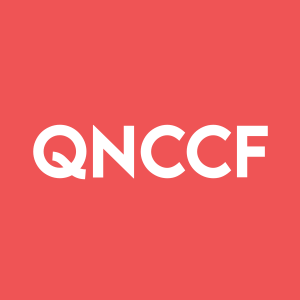CORRECTION FROM SOURCE: Quantum eMotion Announces Successful Completion of Quantum Simulation Project Evaluating Sentry-Q Cryptographic Architecture
Rhea-AI Summary
Quantum eMotion (OTCQB: QNCCF) has completed an internal quantum simulation project to evaluate its Sentry-Q cryptographic architecture. The study, conducted with PINQ², used IBM's Qiskit framework to simulate Grover's algorithm and assess the security of QeM's Quantum Random Number Generator (QRNG).
The key findings revealed that Grover's algorithm's success rate significantly decreases with larger key sizes. At 256-bit key sizes, attacks would require approximately 2¹²⅘ iterations, making them impractical with current quantum hardware. The integration of QeM's QRNG showed increased oracle complexity and circuit depth, suggesting enhanced security against quantum attacks.
Positive
- None.
Negative
- None.
News Market Reaction 1 Alert
On the day this news was published, QNCCF declined 11.50%, reflecting a significant negative market reaction.
Data tracked by StockTitan Argus on the day of publication.
This news release corrects and replaces the news release that was issued by Quantum eMotion Corp. on June 26, 2025 - PINQ2 boilerplate and quote added. There are no material changes to the previous news release.
Montreal, Quebec--(Newsfile Corp. - June 27, 2025) - Quantum eMotion Corp. (TSXV: QNC) (OTCQB: QNCCF) (FSE: 34Q0) ("QeM" or the "Company"), a developer of quantum-secure technologies, announces the completion of an internal quantum simulation project assessing aspects of its cryptographic architecture.
The benchmarking project, conducted in collaboration with PINQ² (Plateforme d'Innovation Numérique et Quantique), utilized IBM's Qiskit quantum computing framework to simulate Grover's algorithm-a quantum search algorithm known for its theoretical ability to speed up brute-force attacks on symmetric encryption schemes. The analysis focused on evaluating the relative complexity of attacking symmetric encryption algorithms when enhanced with entropy from QeM's proprietary Quantum Random Number Generator (QRNG).
Key Observations:
- Simulations indicate that the success rate of Grover's algorithm decreases significantly with increasing key size.
- The integration of QeM's QRNG appears to increase oracle complexity and circuit depth in the simulated quantum circuits, suggesting a higher computational burden for potential quantum attackers.
- At projected real-world key sizes (e.g., 256 bits), Grover's algorithm would require approximately 2¹²⁸ iterations to succeed, rendering such attacks infeasible with foreseeable quantum hardware.
"While our simulations are conducted at small key sizes, the extrapolated trends support a clear conclusion: the integration of our QRNG-generated entropy demonstrates characteristics consistent with strong resistance to quantum attacks," said Dr. Francis Bellido, CEO of Quantum eMotion. "This work strengthens our confidence in the security-by-design approach we are taking with Sentry-Q and our broader post-quantum product roadmap."
Marie-Claude Messier, General Manager (Directrice générale) of PINQ² added: "We are proud that Quebec companies have the opportunity to advance their research and development activities through our cutting-edge infrastructure."
The project lays the groundwork for future validation in embedded and edge environments. Next-phase development will include hybrid testbenches and real-time emulation of cryptographic architectures enhanced with QRNG under constrained computing conditions.
About PINQ²
PINQ² is a non-profit organization offering a digital and quantum innovation platform operating at the provincial and national levels. Through a single interface, it provides access to both quantum and classic computing resources. This collaborative environment lowers barriers related to costs, technical complexity and infrastructure management, enabling businesses and universities to test, validate, and deploy advanced technological solutions. PINQ² operates the only IBM Quantum System One in Canada and supports innovation, particularly in the finance, environmental, energy, aerospace, and life and biomedical sciences sectors.
Media contact:
Marion Urso, Director - Communications Service
DRAKKAR Digital
marion.urso@drakkar.com
(438) 346-4147
About QeM
The Company aims to address the growing demand for affordable hardware and software security for connected devices. QeM has become a pioneering force in classical and quantum cybersecurity solutions thanks to its patented Quantum Random Number Generator, a security solution that exploits the built-in unpredictability of quantum mechanics and promises to provide enhanced protection for high-value assets and critical systems.
The Company intends to target highly valued Financial Services, Healthcare, Blockchain Applications, Cloud-Based IT Security Infrastructure, Classified Government Networks and Communication Systems, Secure Device Keying (IOT, Automotive, Consumer Electronics) and Quantum Cryptography.
For further information, please visit our website at https://www.quantumemotion.com/ or contact:
Francis Bellido, Chief Executive Officer
Tel: 514.956.2525
Email: info@quantumemotion.com
Website: www.quantumemotion.com
Neither TSX Venture Exchange nor its Regulation Services Provider (as that term is defined in the policies of the TSX Venture Exchange) accepts responsibility for the adequacy or accuracy of this release. This press release may contain forward-looking statements that are subject to known and unknown risks and uncertainties that could cause actual results to vary materially from targeted results. Such risks and uncertainties include those described in the Corporation's periodic reports including the annual report or in the filings made by Quantum from time to time with securities regulatory authorities.

To view the source version of this press release, please visit https://www.newsfilecorp.com/release/257106







